
Learning About Leatherbacks: Challenges of Captive Rearing
Mike Salmon, Department of Biological Sciences
Florida Atlantic University
Florida Atlantic University
The fossil evidence tells us that marine turtles arose from aquatic turtles living in brackish waters, a habitat that provided an easy transition for the evolution of other turtle species adapted to marine habitats. The result was an explosion of over 100 new marine turtles in 4 distinct families. Unfortunately two families, which produced extremely large marine turtles, have gone extinct but the remaining two families have hung on and are represented by 6 species of “hard shelled” turtles and a single survivor of the other family, the leatherback or “leathery shelled” turtle. The leatherback is without question the most unusual and distinctive representative of today’s aquatic turtles, and perhaps the most unique species of turtle that ever lived! It is those differences that make these animals so interesting to study, simply because they demonstrate just how remarkably “flexible” and varied the design of a turtle can be.
Instead, their body is covered by smooth skin over a layer of thick connective tissue and fat, in which are embedded numerous small bony ossicles that provide strength but also, flexibility. Body flexibility is important for leatherbacks as they must withstand the extreme pressures associated with diving to depths exceeding 1500 feet in search of food. Their prey are jellyfish, salps and pelagic tunicates (collectively, “gelatinous zooplankton”). Other marine turtles also feed on jellyfish but the leatherback, uniquely, is a feeding “specialist” that exclusively feeds on these organisms. Most of the structural, physiological and behavioral features of leatherbacks are best explained as adaptations to this unique foraging strategy.
Distinguishing Features of Leatherbacks
Leatherbacks are easily distinguished from other marine turtles by the absence of a rigid shell of bony plates (scutes) on their top (carapace) and bottom (plastron) surfaces.
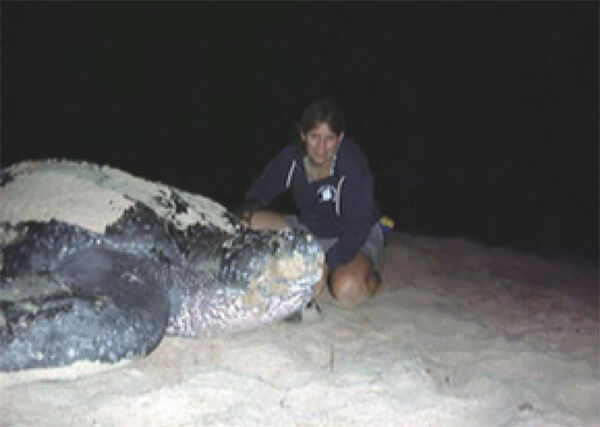
Leatherbacks as adults are huge! (Figure 1). They can reach a length that exceeds 6 feet and a mass of over 2000 lbs, though most adults are smaller. Their large size and rotund shape results in a large body volume, one that allows the turtles to sequester the metabolic heat associated with muscular activity while swimming. That form of warm-bloodedness, called “gigantothermy”, is unique among turtles and, in turn, allows them to search for jellyfish in the colder, more productive northern waters where jellies thrive. Those habitats can’t be tolerated by other marine turtles so leatherbacks have no turtle food competitors.
But a jellyfish diet doesn’t make life easy. For one thing, jellies are a nutritionally poor food source so leatherbacks have to consume them almost constantly, day and night, to obtain enough calories for growth and eventually, for reproduction. Furthermore, jellyfish often exist in low concentrations over widely scattered areas, requiring a continuous search to find them. As a consequence, leatherbacks swim almost continuously and that puts a premium on having a highly streamlined body to reduce drag, front flippers that power them efficiently through the water, and a chest that bulges with muscular power (Figure 2). Leatherbacks routinely swim slowly to conserve energy but when they have to, they can fly through the water at impressive speeds. Finally, we return to another characteristic of leatherbacks: their flexible bodies. Leatherbacks can store large quantities of fat under their skin without much change in their body shape. That’s a very handy characteristic to possess when you can’t be sure of where, or when, you’ll get your next meal. It also enables leatherbacks to overeat at locations where jellyfish are concentrated in “blooms” and store those excess calories as fat reserves.
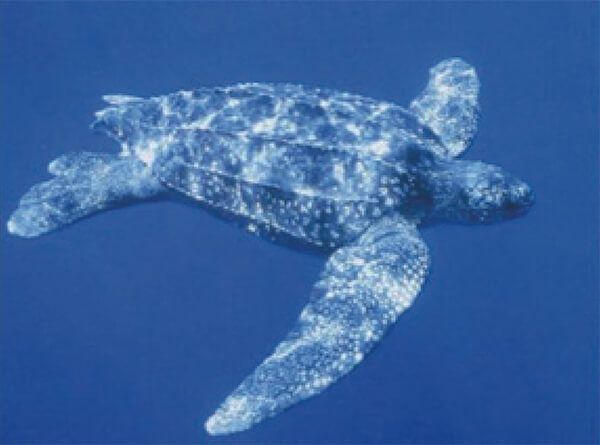
Raising Leatherbacks at the FAU Marine Lab
Turtles generally, and sea turtles in particular, are relatively easy to captive-rear but that statement applies only to the hard-shelled species. Leatherbacks are a different story! The problems are many and varied. Leatherbacks are open-water species that do not recognize barriers and so when kept in tanks, they crash into walls and the bottom, abrade their skin and die either from infection or stress. To make matters worse, they have no ability to swim in a reverse direction. That inability just makes things worse and so to rear them, each turtle has to be tethered by use of a short leash to preserve the illusion that they are swimming in open water (Figure 3).
Green turtle and loggerhead hatchlings are not picky about what they eat. They thrive on a diet of shrimp, fish, and veggies supplemented with reptile vitamins and minerals. They are perfectly content to enjoy a large meal once daily, which makes both food preparation and scheduled feeding easy to arrange and finite in time. Leatherbacks, unfortunately, are a different story! If fed a nutritionally rich diet once daily, they develop digestive problems and die. Instead, both food and feeding must conform to what leatherbacks experience in the wild, that is, they must be fed a low calorie (“jellyfish like”) food multiple times each day, a schedule that resembles the opportunistic and varied tempo of encounters with jellyfish that a leatherback is likely to experience in nature.
Understand Leatherback Behavior
Until recently, much of what we knew about leatherback behavior was based upon scattered observations and more recently, records from instruments attached to the turtles. Thanks to these studies, we now know that leatherbacks often migrate over 1000 miles between their northern feeding grounds and their southern nesting beaches, when and where they dive, and how long they can hold their breath (over 80 min!). Animals captured on their feeding or nesting grounds have been used to determine what they are eating, their internal body temperature, and their genetic relationships. While all of these findings are important, they provide only limited information of interest to behavioral biologists who want to know how these turtles perceive their environment, how they detect and recognize their prey, and how that understanding might be used to manage and protect their populations as leatherbacks are critically endangered. But how does one do behavioral experiments on an animal that is so massive and that requires a steady diet of jellyfish? The trick is instead to work with smaller, and more convenient life-history stages (young juveniles) but that, in turn, means they must be captive-raised. It turns out that rearing leatherbacks in the lab isn’t easy but studies, supported by the National Save The Sea Turtle Foundation, have made advances possible!
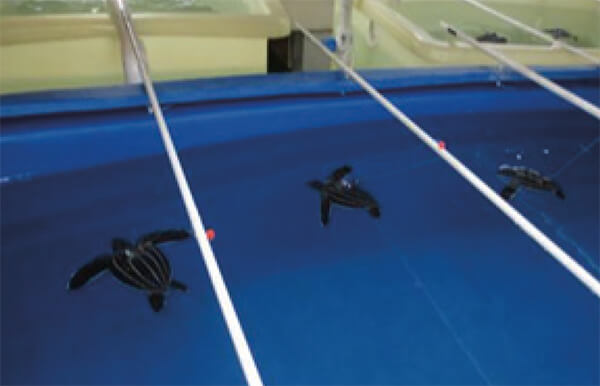


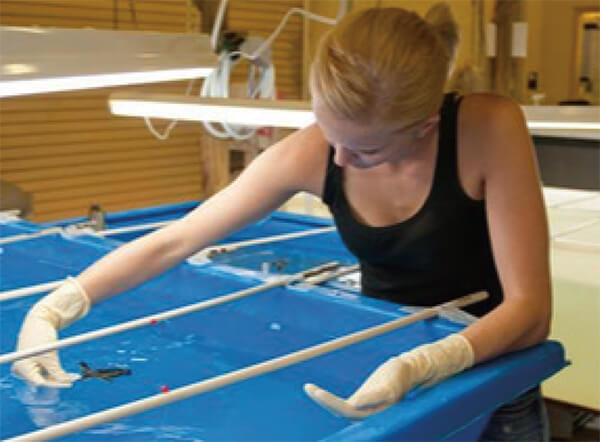
In our lab, that means leatherbacks are fed small quantities 3 times daily (“breakfast, lunch and dinner”) on a diet that is mostly gelatin, with a bit of fish added for protein, plus vitamins and minerals. It takes a lot of help from a crew of dedicated students to feed each turtle individually, and to work all those shifts (Figure 4)!
But as if the above didn’t make things sufficiently difficult, there is another challenge, one that was unanticipated. Leatherbacks hatch with a barely functional immune system that can’t tolerate the higher levels of bacteria and viruses present in our coastal waters, especially during the summer when that water is warm. Normally, hatchlings enter the sea from our beaches and swim swiftly and directly out to sea where the water is both cleaner and cooler. Unfortunately, our laboratory obtains its seawater from a source near shore. We found it essential that the seawater used in leatherback tanks passes through a UV filter (Figure 5) to kill microbes, is purified by a protein skimmer to remove organic compounds, and finally is cooled before it is pumped into a tank housing leatherback hatchlings or juveniles. Even with those precautions, water in those tanks must be partially changed each day to maintain those conditions.
These are lessons that took years of trial-and-error explorations to learn. It’s not surprising that we are the only facility in the world that now raises leatherbacks. It’s a stressful, time consuming and expensive proposition. We’re still perfecting our techniques to improve our success. I’m happy to report that as a result, we are producing some very attractive, fat and healthy juveniles for further study (Figure 6). They can be observed from the Visitors Gallery at the FAU marine lab. Come visit and see for yourself our current brood of growing leatherbacks.
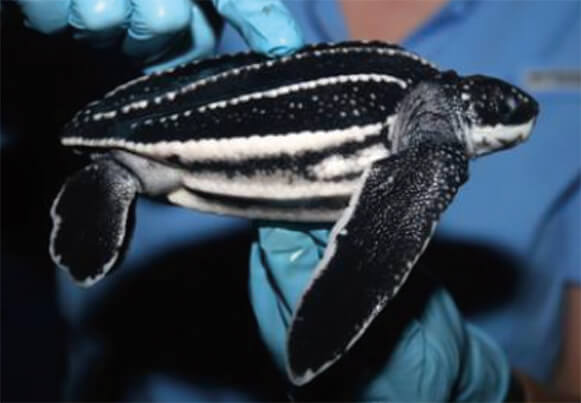
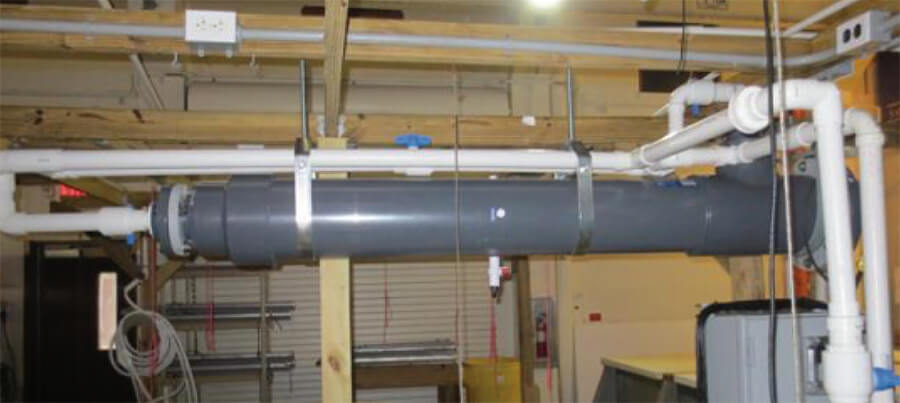
Helping Sea Turtles Survive for 38 Years
A NON-PROFIT ORGANIZATION
State of Florida Registration Number CH-2841 | Internal Revenue Code 501 (c) (3)
Web Design & Development by Web Expressions, LLC

